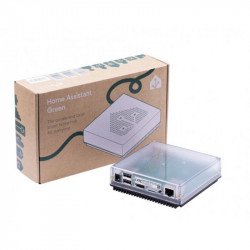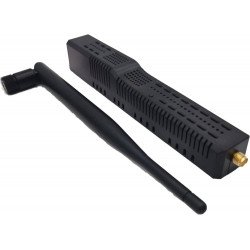LQI Zigbee (Link Quality Indicator) is a key practical criterion to consider when using wireless technologies such as Zigbee to create a simple, cost-effective and flexible smart home, as it measures link quality and communication range.


What is LQI Zigbee?
LQI Zigbee stands for Link Quality Indication and is a link quality indicator of our Zigbee device.

This LQI is a value between 0 and 255.

If we look at the information on the Zigbee2mqtt website, we can see that a maximum LQI value of 255 means that we have perfect link quality with zero error rate.

And as this number goes down, the worse the link quality is, and as long as we have a value above 40, it should be acceptable and our device should work normally.

Let’s start with a simple example. You have a Zigbee home automation hub.

And you have bought a Zigbee device and connected it to this hub. Depending on where you have located this Zigbee device and your Zigbee home automation hub, they will be able to communicate correctly or not.

In general, this direct range is usually indoors, 10 to 15 metres.

But this range is variable at all times and depends on many factors such as:
- Distance.
- Obstacles as furniture.
- Household appliances such as a microwave emitting interference in the same band.
- Wi-Fi routers using the same frequency, 2.4 GHz as Zigbee.
- Obstacle material, e.g. metal, can strongly attenuate the signal.
- The type and thickness of the walls.
- Wind or rain if you use Zigbee devices in the garden.

These are the main criteria that can influence the communication distance of a Zigbee device.

We must also avoid interference, such as moving our Zigbee USB dongle away from the USB port of the home automation hub, which can cause interference due to a deported USB cable.

We have an interesting example of Smlight dongles that work over Ethernet and, by having an RJ45 network cable, allow the dongle to be moved away from the router and not near the home automation hub.

How to verify the LQI Zigbee?
Taking this information into account, we will be able to see what the link quality trend is for each Zigbee device, of course, if our Zigbee home automation hub allows it.

This is the case of Jeedom and Home Assistant with the Zigbee2mqtt platform that we are going to test for this content.

For example, if we include a Zigbee door and window sensor to our home automation hub, now, every time we open or close the door, the LQI is updated and, therefore, we have a trend to know if our sensor has enough range or not.

As you can see, each time we open or close, the LQI is variable although we tend to have a trend with values in the same range.

And if we move this sensor further away, we can see a lower LQI. This is a simple example of direct communication between a Zigbee device and our home automation hub.

Now we are going to see a larger configuration, with different Zigbee devices. They are different devices installed in different places and we can see an LQI of each one.

And if we access the Zigbee network map, as you can see, there is a big spider web between different devices from different brands, which is a very interesting detail, being able to combine brands that use this Zigbee technology and all of them can communicate together.

The devices in blue are the ones that can repeat the signal and are called coordinators, being devices connected to the power, and the star is the Zigbee coordinator, which is usually our Zigbee dongle or a home automation hub that integrates a Zigbee chipset internally, and the devices in green are the “End devices”, i.e. devices powered by battery, batteries or a solar panel.

The interesting thing about Zigbee is that any Zigbee device connected to power can repeat the signal, with the exception of a Zigbee module without a neutral and other isolated cases.

So a thermostat, a shutter module, a light module, a USB dongle, a plug, a light bulb are some of the devices that can repeat the signal.

And there is a device that I find very interesting and that I personally use in the office where I work to repeat the signal of a Zigbee fingerbot to open the electric gate of the building to receive the goods on a daily basis.

This is the Smlight Zigbee dongle.

Whatever the model, these dongles can be used as coordinators, i.e. you can use one with a home automation hub like Home Assistant Green to include all the Zigbee devices and make it the coordinator of this installation… but you can also decide to buy additional Smlight dongles to use them as Routers, i.e. they will repeat the signal as if they were other Zigbee devices like light bulbs, sockets and more.

By having an external, rotating antenna, you will certainly be able to cover the communication range with better performance.

Therefore, you can evaluate this type of product, but of course, any other Zigbee device connected to the mains can be used as a repeater.

And it is worth noting that there are some user experience comments indicating that some brands are good neighbours and others not so good neighbours. That is, there may be some brands that do not help correctly in repeating the signal.

So I recommend you to check user experiences on some specific brands and products before any purchase if you are aiming to improve this Zigbee range.

In this map that we can see, we have, for example, a Zigbee thermostat and two LQIs, 255 and 151.

255 is the quality of the link from the coordinator to the thermostat and 151 is the quality of the link from the thermostat to the coordinator. When you have a device connected to the power and which is a coordinator, you will have 2 LQI values as it is a bidirectional communication.

This thermostat is 1 m away from the home automation hub and therefore the Smlight dongle has excellent link quality with this thermostat, but this thermostat has a lower link quality although it is still a high value.

And as you can see, we have sensors like the door sensor that communicates live with the home automation hub with excellent LQI Zigbee, but other sensors like the smoke sensor does it through a shutter module, also with excellent LQI.

How can we improve the Zigbee LQI?
The first thing we can do is to check if our Zigbee device communicates correctly and 100% of the time. In other words, if we open and close the door 10 times, there is no loss of information, and this is the case for any device.

We can access the entities on our device.

And activate an LQI history to monitor the trend and to know whether or not we need to reinforce the communications signal.

For example, we have a Zigbee motion sensor that typically has an LQI between 160 and 190 over time.

It should be noted that during the night, with no one in the office, the LQI is reported over longer periods, since any battery, battery or solar panel powered device will only wake up every X minutes to send information if there is no sudden change such as a detected movement, a door opening or closing, a large temperature variation or any other event that produces an immediate report.

During the day, as there are movements in the office, each movement causes the LQI to be reported at this time, so we have more activity in this regard.

We have put a Zigbee device connected to the power at medium distance and now, we have a LQI of this sensor between 248 to 255, which is a remarkable improvement.

This is how we can improve the LQI of our sensor, but we can also move this sensor or our Zigbee coordinator if we do not want to buy additional Zigbee devices that can act as repeaters.

Also, in some cases, perhaps the solution may be to upgrade the Zigbee device via OTA so that it can improve communications management.

It is worth noting that this LQI is not visible in different solutions, so in many home automation hubs other than Home Assistant or Jeedom with Zigbee2Mqtt, you will probably be blind with this information.

But as I mentioned, even if you don’t have the data in hand, if you see that a Zigbee device is having communications failures, you can test it near the hub to see if it’s a distance issue.

And, if necessary, you can buy devices connected to the mains to reinforce this signal.

Although, of course, be very careful, you should always verify that each Zigbee device you are going to buy is compatible with your Zigbee home automation hub.

In short, having this information can be of great relevance to create your smart home project with less communication failures and, therefore, having control of your devices from anywhere in the world with your phone and being able to correctly execute the automations that we have created.


Graduated with a Higher Technician’s Certificate in Home Automation, a Professional Bachelor’s degree in E-commerce and Digital Marketing, and a Master’s degree in SEO, I have been working since 2013 in a home automation e-commerce company called Domadoo, where I have the opportunity to test a large number of the popular Smart Home products on the market.